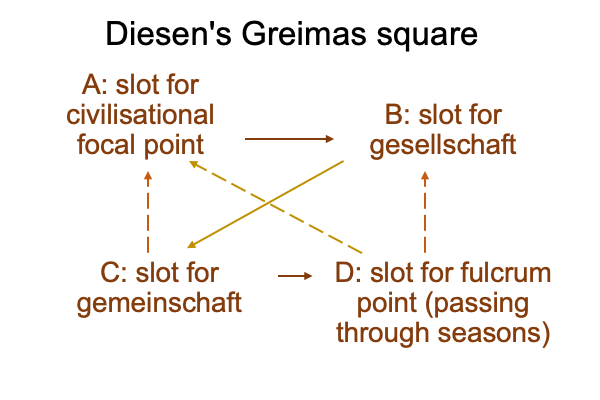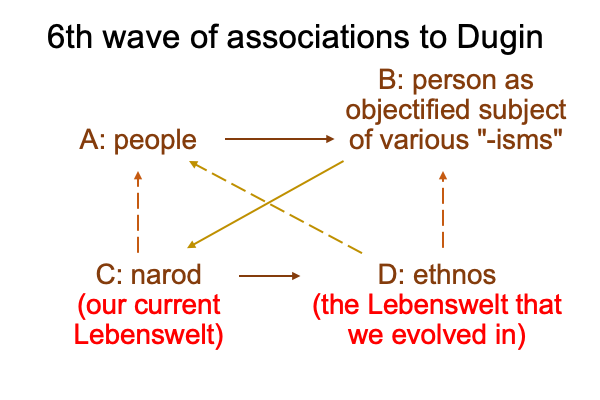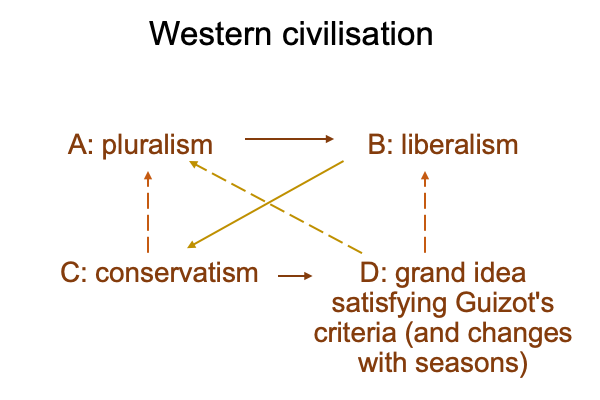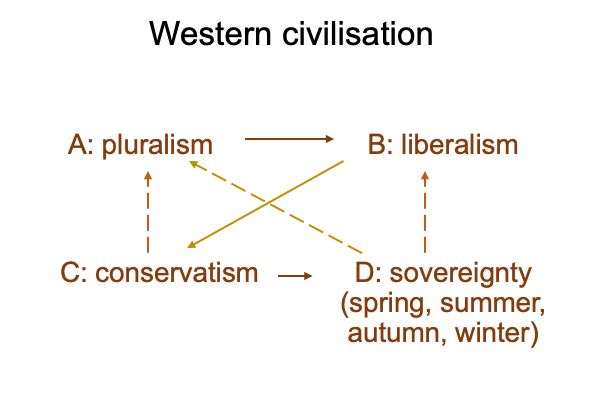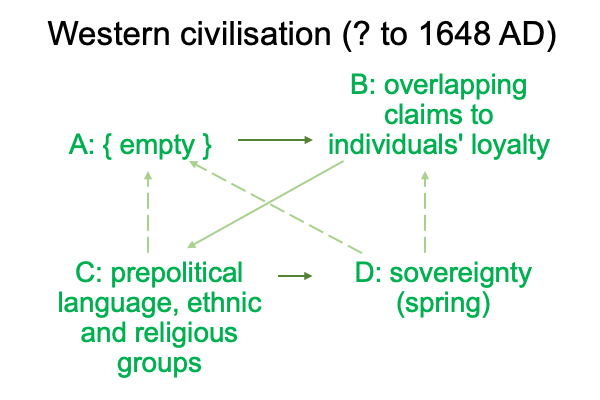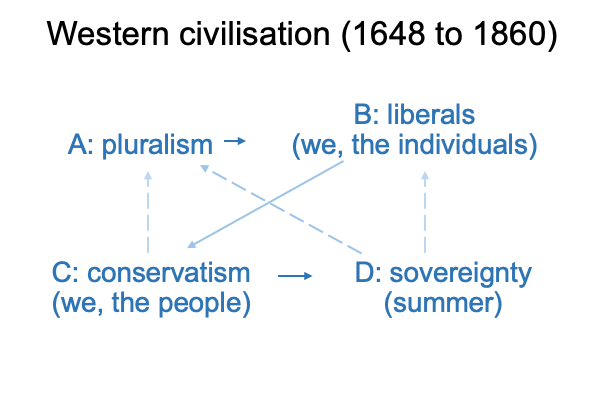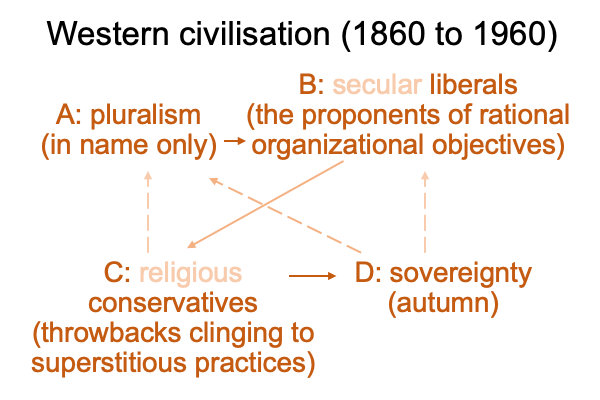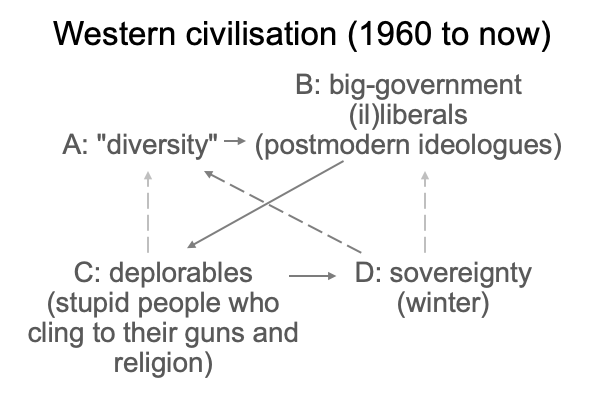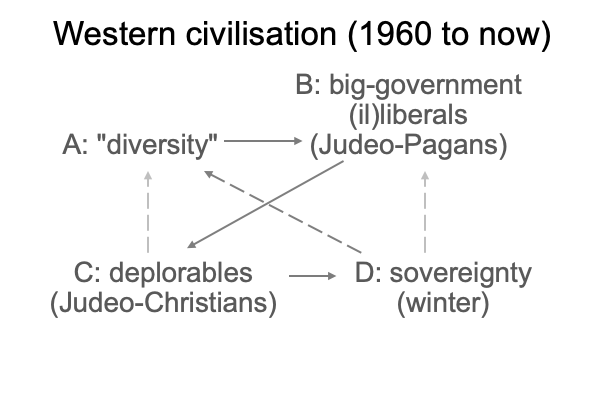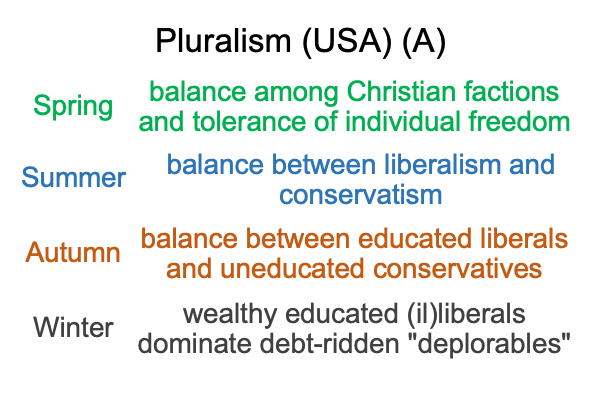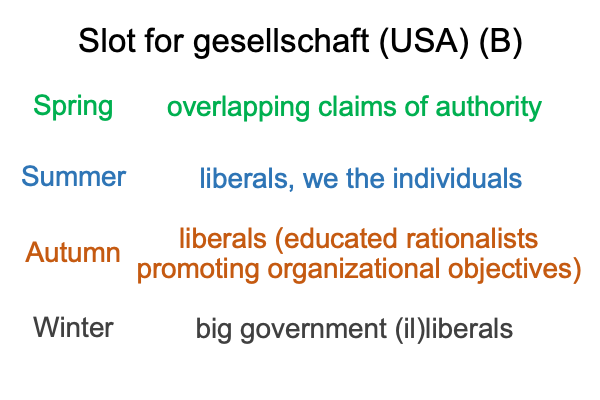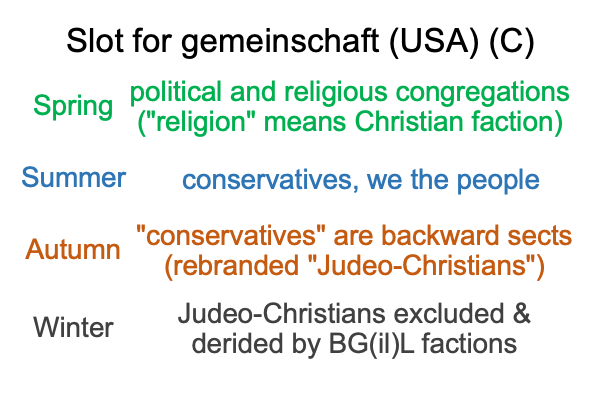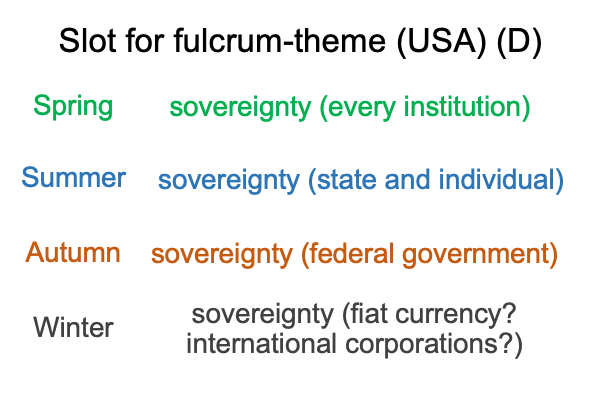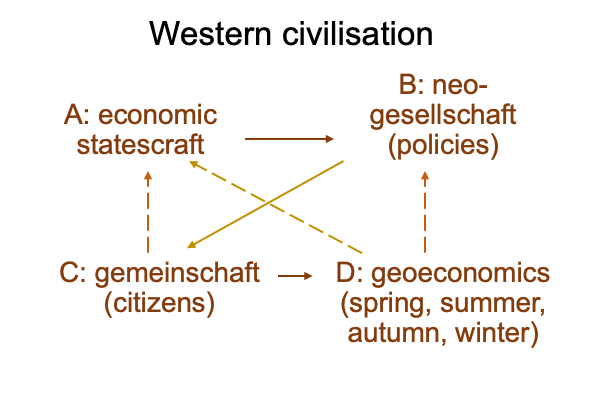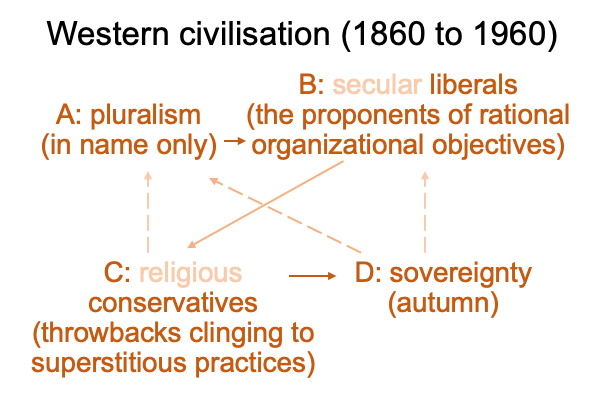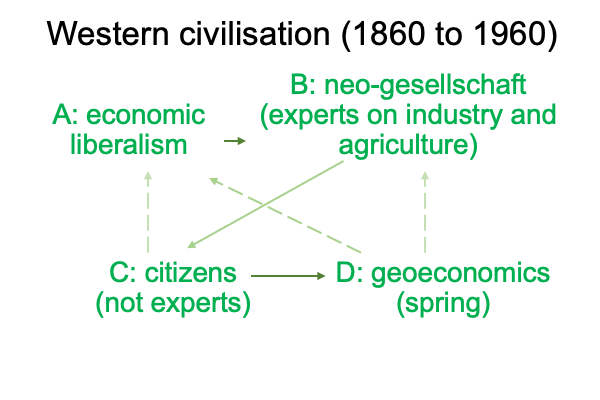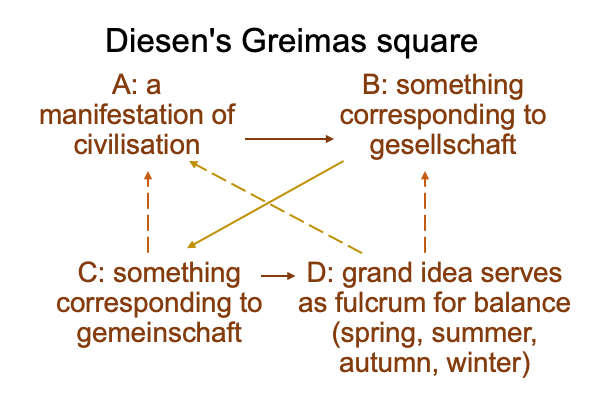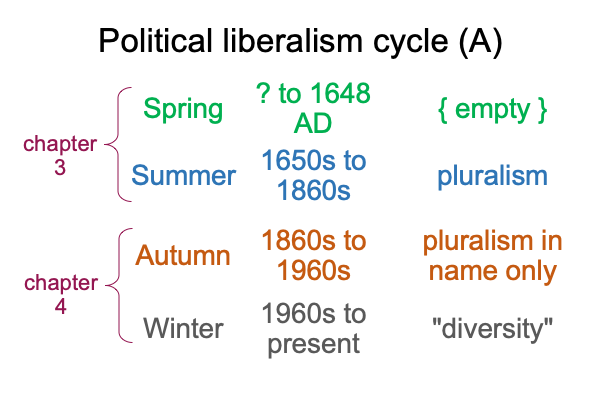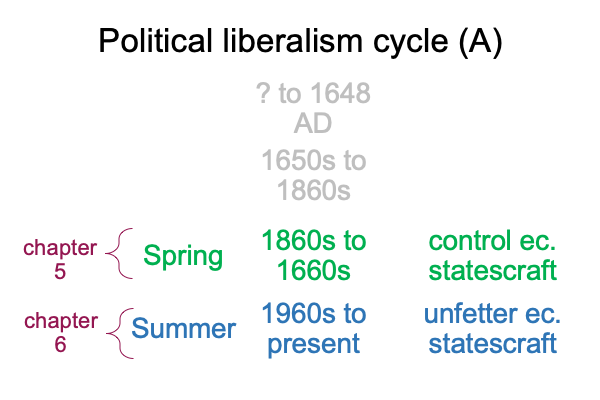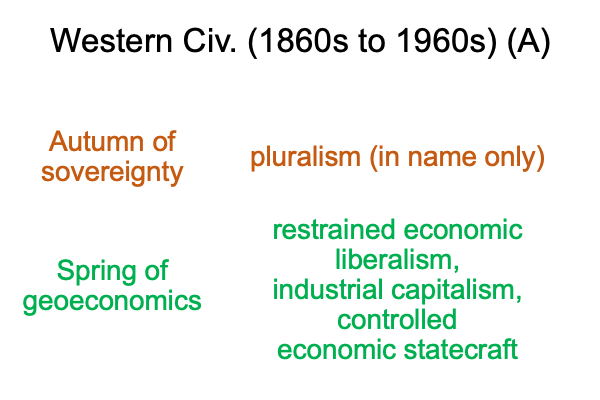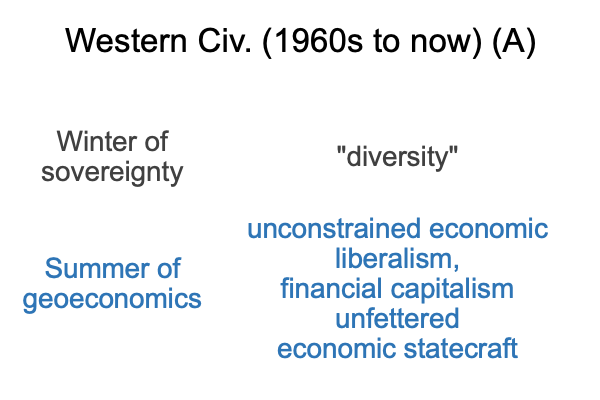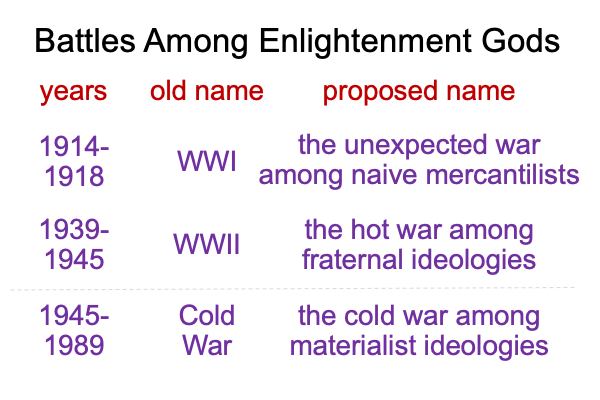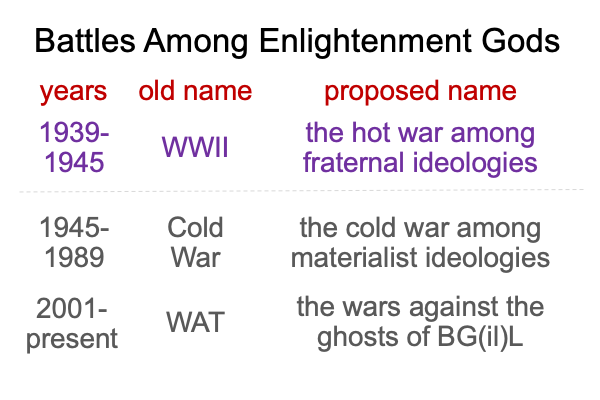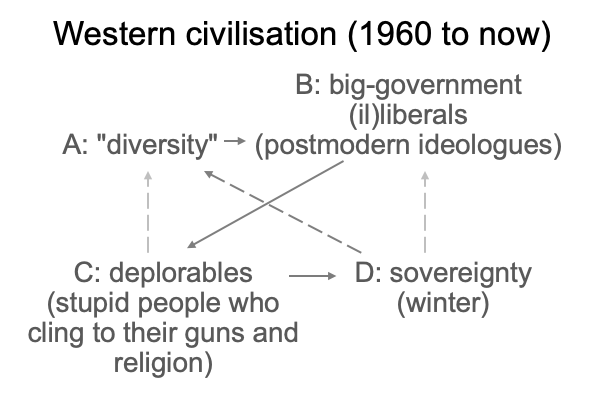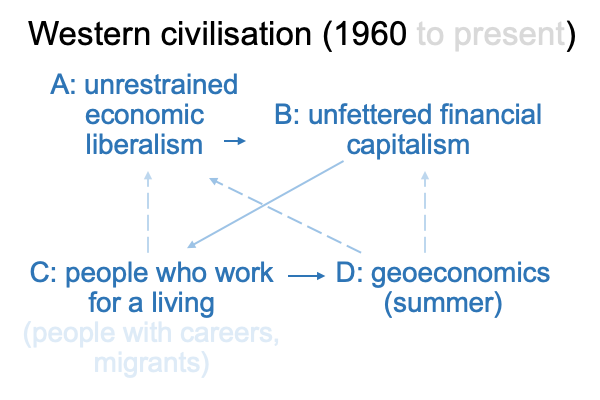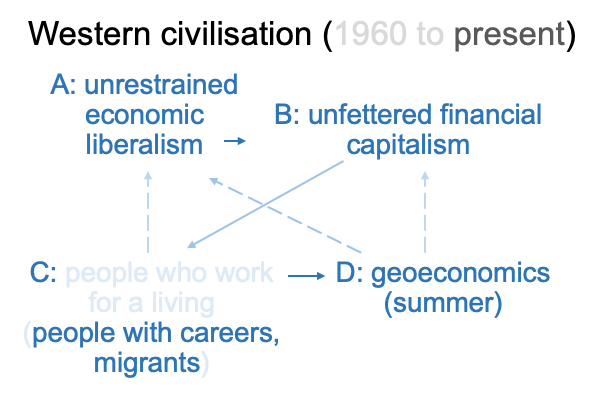Looking at Glenn Diesen’s Book (2019) “The Decay … And Resurgence…” (Part 6 of 21)
0047 The seasons tell a story that revolves around a theme (D). This theme (D) contrasts with gemeinschaft (C) and complements gesellschaft (D). Gemeinschaft (C) embodies the theme (D) in intuition, tradition and community. Gesellschaft (B) tries to frame the theme (D) analytically, using specialized disciplinary languages.
The theme (D) contradicts its manifestation (A), because other manifestations are possible for any particular civilizational theme. By focusing on what is manifest (A), the inquirer cannot formulate the grand theme (D) that it (A) manifests. Indeed, academics may label what is manifest (A) as the grand theme of a civilizational cycle, thereby veiling the implicit grand theme (D).
0048 Here is a picture of the mythic civilizational cycle for what manifests (A).
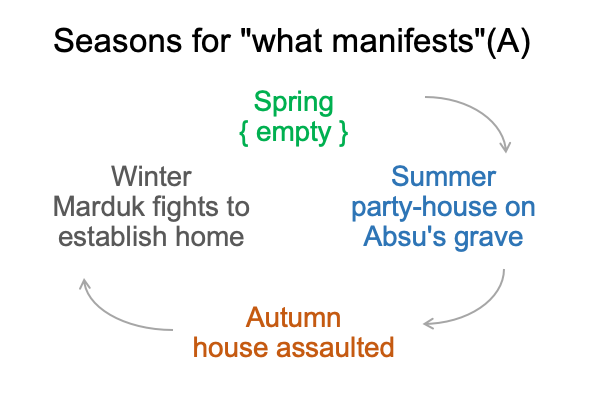
0049 In spring, A is empty.
What does this imply?
The storyteller cannot label the initial manifestation (A) of the theme (D). But, all the elements for labeling the manifestation are present. Absu is order (B). Offspring result from the comingling (C). Tiamat is chaos (D).
Why can’t the storyteller label the initial manifestation?
The particular civilisational cycle that precedes the comingling of Absu and Tiamat is more primal than the our current Lebenswelt, which (for the Babylonians) begins as offspring of the comingling. Perhaps, A may be labeled, “the comingling”. That implies that the prior civilizational cycle is occluded. It cannot be discerned. Additional clues come from the fact that Absu and Tiamat are already divine existents that represent the explicit abstractions of “order” and “chaos”.
0050 Summer covers the murder of Absu, the father, who represents an order that precedes the order that is constructed by the offspring. Absu is an order that is not well articulated by disciplinary languages. The offspring, birthed from both order and chaos, have diverse disciplinary languages. Some of these groups desire to articulate a vision for the entire community, resulting in Absu’s murder (or perhaps, his deconstruction). Upon the grave of Absu, the offspring build a house (a palace with a room for each specialized language group).
The summer season captures the generation of wealth (from labor specializations) and power (from social specializations) potentiated by the adoption of speech-alone talk. Speech-alone talk allows disciplinary languages within a common language, creating factions that may use the same words for differing meanings, presences and messages. One belongs to a group when one automatically processes words according to that group’s potentials. At the same time, each group must project their terminology outwards onto others, generating subtle conflicts that cannot be easily solved through discourse.
0051 Conflict (A) increases in the autumn season. The party palace rocks, as the gesellschaft for each gemeinschaft sees no reason to back down.
The winter season engages the battle (A). Marduk is the god who chooses (or is chosen) to fight.
0052 So far so good. I have applied the timeline of four seasons to what is manifest (A). What about the theme (D)?
Here is a picture of the fulcrum point (D), the grand idea (D) that is hidden by its manifestation (A).
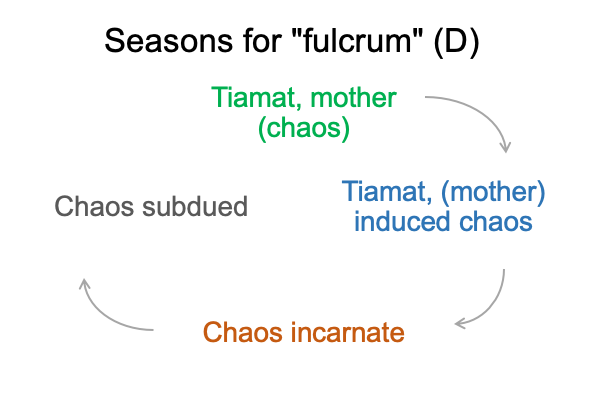
0053 In spring, the fulcrum point (D), the grand idea, is Tiamat, mother and chaos. Tiamat is the oneness of the natural forces of water on the earth. In nature, chaos and fecundity are conjoined. So, the addition of a little order (B), a little specialization, with a concomitant increase in productivity or influence, does not seem so bad. As the comingling continues and the specialized offspring take on lives of their own (C), they conspire against the order that spawned them into existence in the first place.
In summer, the fulcrum point (D), Tiamat, is like a mother of a litter of kids that realizes that something is not right. The kids have killed her original consort and built their party palace to celebrate his demise. Like spoiled brats, each wants the largest room of a house that keeps expanding. Each wants to receive better and better private benefits and impose more and more onerous public costs. They sow the wind without knowing that they will reap the storm.
Tiamat (chaos and continuity) slowly transforms into Tiamat (chaos and discontinuity). The latter Tiamat is what we think of when we hear the word, “chaos”. The transition reflects greater and greater imbalances between gesellschaft and gemeinschaft.
In autumn, Tiamat behaves as Incarnate Chaos. She empowers Kino, who is so monstrous that every chamber of the party palace trembles.
In winter, Kino is defeated. Tiamat is subdued and her remains are used to construct the world in which Marduk rules the house of the gods.
0054 To me, the seasonal shifts in focal point (the house as a home) (A) and the fulcrum point (Tiamat substantially changes in the four seasons) (D) indicate that a manifestation of civilization (A) is not the same as its underlying conceptual being (D).
0055 The cycles for B and C work together.
Here is a picture of the seasons for “gesellschaft” (B).
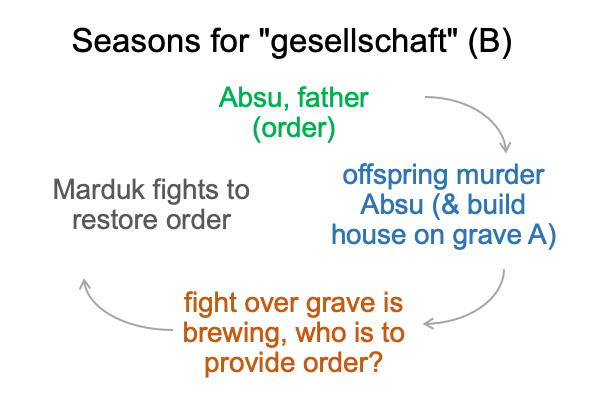
Here is a diagram for the seasons for “gemeinschaft” (C).
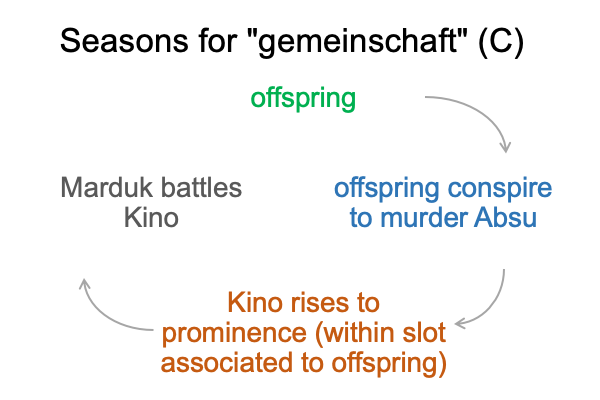
0056 In the spring, an initial articulation of order (Absu, father) (B) comingles with natural chaos and continuity (Tiamat, mother) (D) and produces communities (offspring) (C). What does this imply? Gesellschaft (B) opens the door for specialized community (C). Within a generation or two, that specialized community feels organic (C), because practice accrues implicit abstractions and implicit abstraction is how we evolved to live.
Early inventions in civilization offer examples. The pottery wheel increases productivity in throwing clay vessels. The Absu figure (B, gesellschaft) sees that making a clay pot involves repetitive circular motion. The pottery wheel is an invention that explicitly abstracts this circular motion. I suspect that speech-alone talk is crucial for labeling the circular motion independently of the making of a pot. Throwing pottery using pottery wheels becomes a specialization, with its own group interests (C, gemeinschaft) that works to corral business and restrict competitors (B, gesellschaft).
0057 In the summer, the spawned gemeinschaft (C) shut down the possibility of further inventions in the specialization(B). These actions are explained with terminology that is familiar to the originating order (B) and alien to the originating chaos (D).
Why do I say that the offspring build a party palace on the grave of Absu?
Each room in a party house expresses its own theme. So the murder of an originating order coincides with the elevation of various specialized orders (gesellschaft). Each justifies its own group (gemeinschaft).
In the case of the pottery wheel, I suspect that specialists in using one type of pottery wheel (gemeinschaft) rule out any improvements or adjustments to the pottery wheel (further gesellschaft). Plus, they limit who can use the pottery wheel, thus restricting production to the specialized group (gemeinschaft). These restrictions rely on other specialists, who are devoted to enforcing such restriction. Then, this feedback loop takes on a life of its own. Those who enforce restrictions also strive to restrict entrance into their own markets.
Oh, is there an opportunity for another specialization?
This specialization aims to threaten all other specializations, while demanding payment for “protection”.
0058 In the autumn, gesellschaft strives to articulate an answer to the question, “Who is going to provide order?”
Gemeinschaft responds with Kino, a monster among monsters, consisting of an alliance of political groups successfully dominating or co-opting other alliances.
Do I detect a protection racket?
0059 In the winter, Marduk (a figure expressing the order of a general will, coinciding with gesellschaft) battles Kino (a figure expressing an alliance of specialized groups, each grasping for what it needs to prosper no matter what, coinciding with gemeinschaft in the style of Machiavellian political union).
0060 My conclusion?
Diesen is on target in suggesting that his theory of civilization, here re-articulated as Diesen’s Greimas square, applies to the origin mythologies of ancient civilizations.
But, does that validate Diesen’s Greimas square?
What do other contemporary political philosophers say?

